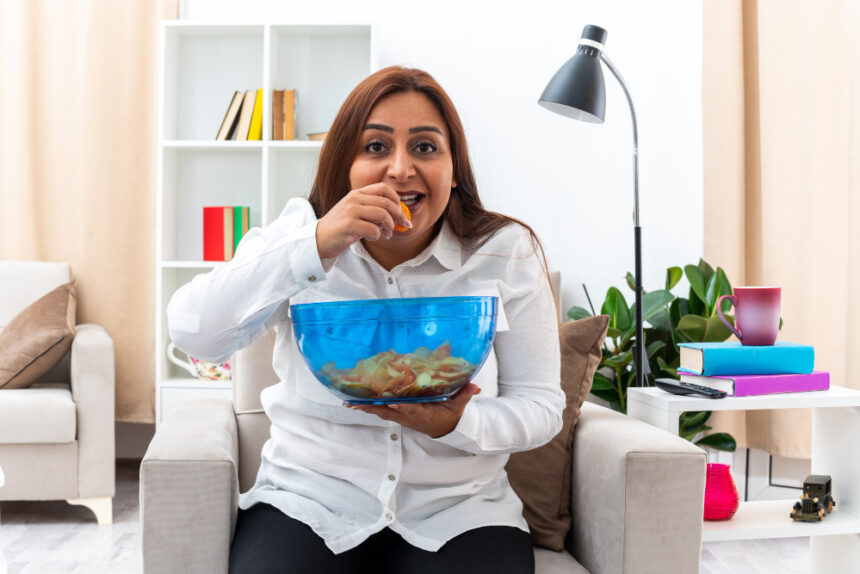A man records himself eating fast food amid piles of cheeseburgers, fish sandwiches, chicken nuggets, hash browns, fries, and, of course, copious amounts of sauce, all with heightened sound to hear his chewing, chewing, and more chewing.
It’s too much food for anyone to eat at one meal on a regular basis, but the video has nearly 5.8 million views, so that seems to be the point for many mukbang videos.
The word “mukbang” is derived from a mashup of the Korean words “meokda,” which translates to eat, and “bangsong,” which means broadcast. The videos usually feature a person recording themselves eating a lot of food on camera while talking to their virtual audience.
Lately, the word has become even more popular by YouTube and TikTok content creators using the term more loosely with their casual “eat with me” and “have a meal with me” videos that have more average-sized meals. By mid-August, there were over 4 million videos on TikTok with the mukbang hashtag.
It’s video after video of foodie influencers, some with millions of followers on the platform, biting into various textured food on camera, the mic catching the sounds of their noisy slurps and crunches. Some of the food combinations are unexpected and even unappetizing, but many people say they can’t look away.
As mukbangs grow in popularity, dietitians are expressing concern about the potential impact of this trend on their audience.
Why are mukbangs popular?
The word “mukbang” began to see a rise in YouTube searches in the beginning of 2015, according to Google Trends, and it hasn’t stopped climbing since. But for off-platform web searches, the word peaked at the start of the global coronavirus pandemic in March 2020.
That could be due to viewers watching for some social connection, as if they were sitting across the table from the mukbang creator, said Grace Derocha, a registered dietitian in Michigan.
Kieanna, a mukbang creator who has been posting videos since October and already has over one million followers, says her most-viewed videos often feature her eating foods that create ASMR-like sounds. (She didn’t want to include her last name since she does not use her full name on her mukbang social media accounts.)
Kieanna was introduced to the world of mukbangs about eight years ago as a viewer. She now records about three to five videos a week, often recording herself in her car trying a wide display of different menu items from popular restaurant chains or in her home eating meals that she has cooked. Sometimes, she gets experimental with unusual foods, such as candy-coated pizza or candy-coated hot dogs, to provide a crisp crunch for the mic and a shocked reaction from her audience, she said.
“A lot of people just use it for entertainment,” she said. “Sometimes, they just say that the food looks good.”
Dietitians concerns about mukbangs
A January 2020 study that analyzed over 5,000 mukbang videos on YouTube found that those that were the unhealthiest—showing someone overeating in a shorter amount of time or eating exceedingly spicy or irritating foods that could cause discomfort or harm—were watched significantly more than the less extreme videos.
“My initial reaction was like, ‘Wow, that’s a lot of food to eat in one sitting,’” said Derocha, who is also a spokesperson for the Academy of Nutrition and Dietetics. The foods are often “not exactly the most nutrient dense or healthy.”
Derocha says she’s concerned that the more extreme videos could encourage some viewers to overeat, avoid certain foods or fail to eat the various nutrients their bodies need.
A person with a restrictive eating disorder could use the videos to fulfill the sense of eating without eating any food, said Suzanne Fisher, a registered dietitian based in Florida who works with patients trying to improve their relationship with food.
“I think a lot of it is almost voyeuristic in a way, almost romanticizing what it would be like to consume such a large amount of food,” Fisher said.
The viewers also don’t know what happens off camera, Fisher said. Some videos could be edited in a way that viewers think the food is being consumed, but the mukbang creator is actually spitting it out between takes, she added.
Kieanna said she tries to be transparent with her audience, letting people know in the comment section that she often does not eat all the food shown and exercises off camera.
“There’s a lot that goes on behind the scenes of it,” she said. “I feel like people probably should just use it for entertainment and shouldn’t really take it too seriously because, at the end of the day, it’s just social media. Social media isn’t necessarily real, so you can’t really believe everything you see.”
Not all mukbangs are the same
Some mukbangs could have a positive influence, such as a video that inspires others to try a nutritious recipe, Derocha said. “It could be a source of inspiration for someone to step outside of their box and try something new.”
Rosemarie Dehesa is a content creator with over half a million followers on TikTok and has posted videos of her cooking, eating, and working out since 2022. Dehesa enjoys creating and posting the mukbangs to connect with other people across the world who share a passion for food.
AMANI Nesta

